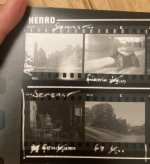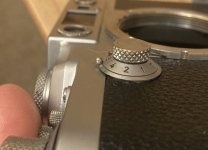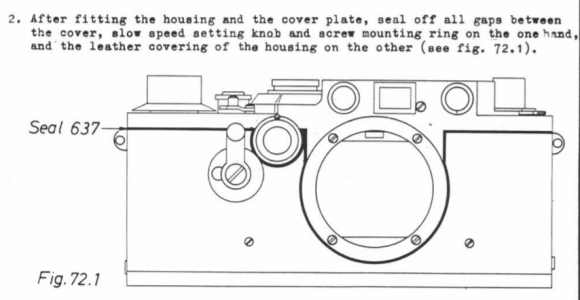Coldkennels
Barnack-toting Brit.
My IIIg came back from a shutter curtain replacement with a new light leak:

It varies in severity, usually just looking like a bit of a pale patch in the same area - you can see a faint example of it in the park image on the bottom right. It's usually really tough to spot, so it was only on the 6th roll after service that I realised it was definitely a light leak and not a bit of unusual flaring. Sure enough, having looked through the last few rolls, whenever that "flare" cropped up, it was always in the exact same spot, occasionally extending into the sprocket holes, which meant my first thought of "bad shutter curtain material" went out the window.
I did some digging and it turns out this is a not-uncommon problem when the vulcanite around the slow speed dial is damaged or not solidly in place, and sure enough:

The vulcanite is somewhat "bunched up" and wasn't laid flat when the camera was put back together. Poking around with a torch confirms this is the source of the leak - it's hard to get the angle exactly right, but it definitely shines through to the chamber take-up spool when the torch is pointed at a certain spot.
So this begs the question: surely the vulcanite isn't the only thing preventing a light leak here? That seems like a bit of an odd design choice. Is there some sealing (foam, string, twine, etc.) that's normally behind the slow shutter speed dial that might not have been replaced when the camera was reassembled? Or is this just a case of lay the vulcanite flat again (hoping it doesn't break off in the process) and everything should be fine?

It varies in severity, usually just looking like a bit of a pale patch in the same area - you can see a faint example of it in the park image on the bottom right. It's usually really tough to spot, so it was only on the 6th roll after service that I realised it was definitely a light leak and not a bit of unusual flaring. Sure enough, having looked through the last few rolls, whenever that "flare" cropped up, it was always in the exact same spot, occasionally extending into the sprocket holes, which meant my first thought of "bad shutter curtain material" went out the window.
I did some digging and it turns out this is a not-uncommon problem when the vulcanite around the slow speed dial is damaged or not solidly in place, and sure enough:

The vulcanite is somewhat "bunched up" and wasn't laid flat when the camera was put back together. Poking around with a torch confirms this is the source of the leak - it's hard to get the angle exactly right, but it definitely shines through to the chamber take-up spool when the torch is pointed at a certain spot.
So this begs the question: surely the vulcanite isn't the only thing preventing a light leak here? That seems like a bit of an odd design choice. Is there some sealing (foam, string, twine, etc.) that's normally behind the slow shutter speed dial that might not have been replaced when the camera was reassembled? Or is this just a case of lay the vulcanite flat again (hoping it doesn't break off in the process) and everything should be fine?
HiMy IIIg came back from a shutter curtain replacement with a new light leak:
It varies in severity, usually just looking like a bit of a pale patch in the same area - you can see a faint example of it in the park image on the bottom right. It's usually really tough to spot, so it was only on the 6th roll after service that I realised it was definitely a light leak and not a bit of unusual flaring. Sure enough, having looked through the last few rolls, whenever that "flare" cropped up, it was always in the exact same spot, occasionally extending into the sprocket holes, which meant my first thought of "bad shutter curtain material" went out the window.
I did some digging and it turns out this is a not-uncommon problem when the vulcanite around the slow speed dial is damaged or not solidly in place, and sure enough:
The vulcanite is somewhat "bunched up" and wasn't laid flat when the camera was put back together. Poking around with a torch confirms this is the source of the leak - it's hard to get the angle exactly right, but it definitely shines through to the chamber take-up spool when the torch is pointed at a certain spot.
So this begs the question: surely the vulcanite isn't the only thing preventing a light leak here? That seems like a bit of an odd design choice. Is there some sealing (foam, string, twine, etc.) that's normally behind the slow shutter speed dial that might not have been replaced when the camera was reassembled? Or is this just a case of lay the vulcanite flat again (hoping it doesn't break off in the process) and everything should be fine?
There is, indeed, a sealing strip which should be glued to the inside of the body shell to prevent such leaks. I always carefully inspect its condition, and replace if necessary, it is not hard to do. It's almost a DIY job for IIIc–IIIf models without a self timer. But if equipped, the timer lever and its connections to the actual escapement must come first out to slide off the shell and obviously this includes all IIIg types. I have done this, but find the task of refitting the timer components irritating. I have much appreciation for many aspects of the screw mount design, but the timer external parts are one of the dumbest installations I've ever seen in a camera. As you've just had the camera worked on, however you shouldn't need to concern yourself with this. Send it back for re-sealing.
Dralowid
Michael
Yup, as Brett says that sealing strip is pretty basic stuff. Someone might have been rushing to finish the job after doing the curtains. Send it back so they know the error of their ways.
I don't like self timers, having moaned about them in the past and been put in my place by those who consider them indispensable I had better shut up now.
I don't like self timers, having moaned about them in the past and been put in my place by those who consider them indispensable I had better shut up now.
Coldkennels
Barnack-toting Brit.
I don't like self timers, having moaned about them in the past and been put in my place by those who consider them indispensable I had better shut up now.
I'm with you on this. I actually bought this IIIg on eBay specifically because it's had the self timer professionally removed at some point in its life. Not only does it make for a better looking (and better to hold) camera, but it saved me a small fortune - barely anyone bid on it, presumably because it looked dodgy as hell. Win/win, if you ask me. It does now mean the entire body shell on this IIIg is held on with just two brass screws, though. Again, weird design choice. But hey, it's survived this long, I'm sure it'll be fine for years to come.
There is, indeed, a sealing strip which should be glued to the inside of the body shell to prevent such leaks. I always carefully inspect its condition, and replace if necessary, it is not hard to do. It's almost a DIY job for IIIc–IIIf models without a self timer [...] As you've just had the camera worked on, however you shouldn't need to concern yourself with this. Send it back for re-sealing.
I took the body shell off last night to check it out and stuck some adhesive-backed sponge in the offending area. Hopefully that'll do the job - I don't really want to send the camera back out and be without it for another god-knows-how-long just for a little bit of foam!
I knew a RFF member had a IIIg with timer removed, but had forgotten it's you, sorry. Otherwise I would have added the extra detail following below, earlier.I'm with you on this. I actually bought this IIIg on eBay specifically because it's had the self timer professionally removed at some point in its life. Not only does it make for a better looking (and better to hold) camera, but it saved me a small fortune - barely anyone bid on it, presumably because it looked dodgy as hell. Win/win, if you ask me. It does now mean the entire body shell on this IIIg is held on with just two brass screws, though. Again, weird design choice. But hey, it's survived this long, I'm sure it'll be fine for years to come.
I took the body shell off last night to check it out and stuck some adhesive-backed sponge in the offending area. Hopefully that'll do the job - I don't really want to send the camera back out and be without it for another god-knows-how-long just for a little bit of foam!
Page 38 of the pdf for the Leitz IIIf service manual (linked below) helpfully shows the placement of the required seal. The parts list calls it a "velvet strip" which matches my assessment of the material. If needed the velvet seals from the slots of two Kodak 35mm cassettes can be repurposed to good effect (one piece from one cassette will not be quite long enough, but two may be affixed very close together, and adjusted for length).
https://learncamerarepair.com/produc...2&secondary=27
Personally, I often find a timer quite a convenient way of releasing a shutter with no vibration. And the actual escapement Leitz fitted to the IIIf and IIIg is beautiful quality. (Sourced from Gauthier or Deckel I believe?) The connecting parts between actuating lever and said escapement, on the other hand, are not immune from slipping out of place.. Perhaps I have unreasonable expectations, but Leitz's implementation of an Oldham coupling and their associated shims etc. could be improved on. Thus, I have little interest in using a screw mount so equipped (having previously disassembled a IIIf to retrieve, and reinstall, a loose distance piece). Your IIIg on the other hand, would be the rare example of the model I could actually envisage using, myself.
By the way, on the forum page list of recent threads (home page) this one currently has "0 responses". Anyone else see this glitch?
Coldkennels
Barnack-toting Brit.
Page 38 of the pdf for the Leitz IIIf service manual (linked below) helpfully shows the placement of the required seal. The parts list calls it a "velvet strip" which matches my assessment of the material.
Wow, I didn't think it would be so long. I literally only put a bit of padding across the top - there's a noticeable gap between the shell and the front plate of the camera body at the top, so I figured blocking that up with some easily-compressible sponge would do it. I'm unlikely to be in enough sun for it to be a problem for the next six months now (the joys of living in England), but if that hasn't fixed the problem, I'll recreate the strip as shown using some adhesive-backed velvet I have lying around.
And the actual escapement Leitz fitted to the IIIf and IIIg is beautiful quality. (Sourced from Gauthier or Deckel I believe?) [...] Your IIIg on the other hand, would be the rare example of the model I could actually envisage using, myself.
I do think the Leitz self timers are beautiful things, but it's just an unnecessary bit of metal on the front of an otherwise quite simple and clean body. I'm prone to carrying a Barnack with either the lens in the crook between finger and thumb or by wrapping my fingers around the curve of the body at the winding end, palm of the hand flat on the back of the camera; with either method, the self timer is in the way. It's bloody annoying.
Incidentally, the latter carrying method is one of many reasons I've always hated the Canon rangefinders - that angled end doesn't feel as good in the hand.
By the way, on the forum page list of recent threads (home page) this one currently has "0 responses". Anyone else see this glitch?
I've seen this a few times since the new version of the forum went up. Not sure what causes it - another one for the list of errors on the new software, I guess.
Dralowid
Michael
Up to you of course but however much we want to keep in our precious repair people's good books it is as well to let them know of the problem and that you have solved it.
If we don't tell them how will they ever know?
If we don't tell them how will they ever know?
Coldkennels
Barnack-toting Brit.
It's a valid point. That said, he told me he's basically due to retire, so it's not like he's going to be taking on many more jobs anyway.
I'll have a ponder. I still have a IIIf in need of new shutter curtains so maybe it's in my best interest to point this out.
I'll have a ponder. I still have a IIIf in need of new shutter curtains so maybe it's in my best interest to point this out.
qqphotos
Established
Hi
There is, indeed, a sealing strip which should be glued to the inside of the body shell to prevent such leaks. I always carefully inspect its condition, and replace if necessary, it is not hard to do. It's almost a DIY job for IIIc–IIIf models without a self timer. But if equipped, the timer lever and its connections to the actual escapement must come first out to slide off the shell and obviously this includes all IIIg types. I have done this, but find the task of refitting the timer components irritating. I have much appreciation for many aspects of the screw mount design, but the timer external parts are one of the dumbest installations I've ever seen in a camera. As you've just had the camera worked on, however you shouldn't need to concern yourself with this. Send it back for re-sealing.
I also had a IIIg return from repairs with this same light leak. I sent it back again to have that addressed, but now having read your comments and my correspondence with the repairer, I don't believe he is aware of the sealing strip that should be glued inside the body, so I suspect I'll have to do this myself when it eventually finds its way back to me, since a six month turnaround every time I send it back really adds up.
Coldkennels
Barnack-toting Brit.
Turns out my tiny piece of light sealing foam wasn't enough, so I had to revisit this thread and have now recreated the missing strip shown in the repair manual to the best of my ability.
However, the repair manual also mentions this:

"Seal 637" is given in the parts list as a type of wax. Has anyone ever bothered doing this?
However, the repair manual also mentions this:

"Seal 637" is given in the parts list as a type of wax. Has anyone ever bothered doing this?
Share:
-
This site uses cookies to help personalise content, tailor your experience and to keep you logged in if you register.
By continuing to use this site, you are consenting to our use of cookies.

